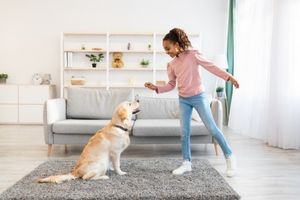During the Summer months, our dogs are spoiled with extra attention from kids home from school on Summer break. They enjoy extra playtime, more cuddles, and less time alone. However, some dogs struggle when Summer break ends and their human siblings return to school and college. This is especially true for dogs that already suffer from separation anxiety when you leave home or go on vacation without them. To make the back-to-school transition easier on your four-legged family member, we're offering tips to help them ease into the school year schedule.
What is Separation Anxiety?
Separation anxiety occurs when a dog is excessively attached to their owner and exhibits signs of stress when separated or left alone. While some dogs will whine when their owner leaves or perhaps even get mischievous in the house as retaliation, separation anxiety goes deeper.
Signs of separation anxiety in dogs include:
- Excessive howling, barking or whining for a long duration of time
- Indoor "accidents" despite being housebroken
- Chewing furniture, digging holes, scratching at doors, and other destructive behavior
- Panting and drooling more than usual due to an elevated heart rate from stress
- Obsessive pacing
- Trying to escape
- Lethargy and disinterest in playing
- Reduced appetite
Tips to Alleviate Separation Anxiety
If your dog suffers from separation anxiety, getting them to remain calm when separated from you isn't an overnight fix. It requires patience and a repetitive change in habits to help them understand that you will come back and they'll be okay in the meantime.
To alleviate separation anxiety in dogs:

Be Generous with Treats
Purchase a puzzle toy for your dog—for example, one that you stuff with treats or peanut butter (ensure it's xylitol-free)–and have your kids give it to your dog before they leave for school. This extra-special treat will help them realize that the kids' departure means they get a treat, which also will occupy their time while they're gone.
Schedule Morning Exercise Time
During the first few days back to school, give your dog extra activity in the morning before the kids leave. Additional activity can be an early morning walk or an extra play session. A nice nap will help the time pass. The American Kennel Club provides insight into your dog's ideal amount of exercise.

Don't Be Over-the-Top With Goodbyes and Hellos
While it's tempting to give lots of kisses, rubs, and hugs when you're leaving, it's best to keep your departure low-key, which tells your dog that it's not a big deal that you're going. When returning, ignore your dog for a few minutes before greeting them. This combination of minimalist goodbyes and hellos will help your dog understand that temporary separation is a normal part of their day.
Leave Them With Your Scent
Similar to how a reputable breeder will provide a blanket with the scent of your new puppy's mother to ease their transition into your home, you can do the same when you need to leave your dog for an extended time. Leave behind an article of clothing recently worn, and your dog will feel more relaxed with your scent nearby.

All-Natural Calming Supplements Or Medication
If your dog has had several episodes of separation anxiety and you know back-to-school is quickly approaching, consider a safe, over-the-counter natural calming supplement for the first few days your kids are back at school. However, check with your veterinarian before giving anything new to your dog. In severe cases where the dog still exhibits extreme anxiety even after working with a trainer and/or animal behaviorist, your veterinarian might recommend short or long-term medication.
Elevated Separation Anxiety
Some dogs have such bad anxiety that they'll start whining and pacing as soon as they see a family member putting on shoes or grabbing a coat. They might even try to stop you by placing their paw on your foot or jumping up on your leg to keep you from leaving. This level of separation anxiety requires a slower, more methodical approach to help break them of this extreme anxiousness.
For dogs with this level of separation anxiety, put on shoes or grab your coat but remain in the house. Sit on the couch, grab a snack, or do some laundry while wearing those items. This will demonstrate that shoes and coats don't necessarily mean you're leaving and will stop triggering separation anxiety in your dog.
Once your dog shows signs of remaining calm when you're wearing shoes and a coat, take the next step and leave them in increasing increments. Start with just one minute, separating yourself from your dog behind a door. Once they remain relaxed for that minute, slowly increase the time they can't see you. Eventually, your goal is to leave for a quick errand without them showing anxiety and gradually build up to longer excursions.
To learn more about helping your dog overcome separation anxiety, contact us. The ASPCA is another excellent resource on separation anxiety in dogs. And again, in worst-case scenarios, we might recommend medication to ease your dog's nerves, as no one wants to see a precious pet upset on a regular basis.
